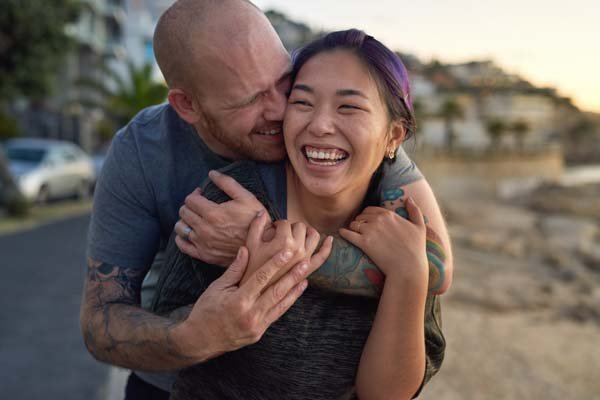I wanted to write a blog post about the ways I get tripped up personally in my relationship with my wife. Why? I’ve always felt it is a real public service for leaders in the mental health community to talk about their own struggles. It humanizes things. It normalizes what you may be feeling, so instead of feeling like “something is wrong with you,” you can understand things as “I’m a human experiencing human things.” It stands to give readers that universal salve: hope. (See this article in the New York times on Dr. Marsha Linehan talking about her own depression)
Everyone Has An Attachment Style
There are 4 types of attachment styles that people adopt: anxious, avoidant, anxious/avoidant or secure. These styles are what people use from a combination of their genetic makeup, child-rearing, and accumulated adult experience.
Upside/Downside of Anxious Attachment
I have an anxious attachment style. In the context of my marriage, this means that I pursue resolution of difficult conversations. The upside of this is that there is someone who is looking after the relationship and saying “something’s not right between us. Let’s figure out the problem.” The down side is that the same mechanism that provides energy to do that is an anxiety system. In reaction to my anxiety, I can express irritation, annoyance, frustration, anger, or rage.
You can imagine ways my spouse would react to that irritation, frustration, annoyance, anger, or rage:
It can look like shutting down because you’re overwhelmed.
It can look like shutting down because you want to yell back, but know that isn’t good.
It can look like yelling back at the other person.
It can look like leaving the premises.
It can look like leaving the premises in a huff, possibly slamming a door on your way.
It can look like staying logical (but is actually withdrawing from the emotion through logic).
It can look like lecturing the other person on what is happening psychologically (but is actually withdrawing from the emotion by talking logically about the emotion and not feeling the emotion).
An Example Of My Attachment Style
Let’s go back to my example and how my anxious attachment gets in the way of my marriage.
Here’s an example:
I get hurt by something my wife says or does. This week, it was her very obvious irritation with me that we were waiting a line for a restaurant that I’ve wanted to try on vacation. Now this is after a whole day where I felt like I was constantly running interference with the kids so that she could maximize her experience.
She makes me work for it - she makes me ask for what I need, which is for her to be generous and giving in a moment that feels like it’s going to extract something from her. I feel unimportant and my needs dismissed.
I get really irritated because what I want is for her to be generous and motivated to pursue my happiness. All of this after feeling like I was being a supportive spouse the whole day.
A story starts developing in my head. It is about being really supportive and not getting support. It is about loving her, but not getting love in return. I start feeling lonely and insecure.
It is getting dark in my head. I feel more alone, even as we’re standing in line for the restaurant that I chose. I say with some resentment and pettiness that “I’m accepting her offer to stay in line.” She says back,”It is what I offered.”
I don’t believe what she just said because her tone is not generous.
Things get better after we’re seated. Things get even better after we’ve eaten.
That night I talk to her. I told her that it would be great if she could show me support on things in the vacation I loved. It kind of took away the specialness giving me support if it was reluctant.
It occurs to me to ask her if she felt reluctance on my part when I was at the museum with the kids?
She says “yes.”
I am truly flummoxed. I was attempting to push us to go faster to the last exhibit, as this was the exhibit she wanted to get to. We kept stopping for questions from our 5 year old, but I thought he wouldn’t make it to the final exhibit.
At first I say “What? There’s no way . . .” Then I stop and actually ask her,”Did you feel like I was reluctantly participating? When did you feel that way?”
I explained this to her. She thought I was trying to get out of the museum faster, when all I wanted was for her to maximize her experience while dealing with tired children as little as possible.
She explained that she was hungry while we were waiting in line. I didn’t even understand that she was hungry. She had eaten a snack prior to us going, so the thought hadn’t even entered my mind.
We both apologized for hurting the other person, and each of us forgave each other.
The Post-Mortem
Believe it or not, this was a very difficult experience for me. It didn’t span more than 12 hours from the first attempts at me being supportive to the conversation resolving everything that night. But it felt really, really terrible.
The developing story in my head was dark and full of feelings of abandonment that I experienced as a child. It felt really lonely. It was the first international vacation we experienced together, and certainly the first time we’d all gone as a family. So not only was it full of difficult emotions, it was full of triggers from my childhood, and the story in my head was “what does this mean for our relationship moving forward?”
The Anxiety Part of Anxious-Attachment
As I alluded to earlier, the anxiety part of anxious attachment provides the energy to pursue the resolution of difficult conversations. My anxious attachment tells me that it’s my job to make sure the relationship is ok. If I had avoidant-attachment, my avoidance would tell me that it’s better to shut down or go away until the hard thing blows over. I have a post dedicated to what the anxiously attached person feels and what the avoidant attachment person feels.
But the downside is that my anxiety can come across harshly. Remember that in the moment, I felt entitled to yell at my wife because I felt abandoned. I spent the whole day trying to be supportive to her, and she couldn’t wait in line with me for 30 minutes for a good meal. Furthermore, the developing story in my head was that maybe we weren’t a good match together and specter of growing apart was rising in my anxious mind.
All of these thoughts and feelings led to a rising tornado of anxiety from “I’m hurt” to “she doesn’t care” to “she doesn’t love me” to “we’re doomed as a couple.”
The Story In My Head
When this developing story in my head was ripe with hopelessness, it was really hard to get perspective. I didn’t know in that moment whether it was a bump in the road, or the beginning of one of those concrete road barriers. And I wouldn’t know until we had a chance to calm down.
If the story in my head was we were done in our relationship, it would seem reasonable in the moment to yell at her while standing in line for a restaurant. Because I’m trying to get her attention to something that is dangerous for our relationship! My anxiety system is telling me that a big problem demands a big reaction. I have a post on the concept of “the story in my head.”
This is why calming is an essential part of recovering, or getting out of our cycle. Because if I’m in this tornado of emotions, only big reactions seem the reasonable next step. But only after I calm down can I have a real conversation with her. And only after that real conversation do I find out important things like:
She thought I was reluctantly participating the whole day, when I was actually trying to deliver the best experience for her.
She didn’t even know I was mad at her for not being generous in that line.
Getting Off Our Relationship Cycle
Part of the calming had to happen over time. Part of the calming had to happen through awareness of what was happening to me. Part of the calming was through exercise and walking outside. Part of it was situational - we got seated and started eating.
Each of these things helped to lead us off of our cycle that we were both experiencing. But the contribution that I could make was helping to skip the peak parts (by not doing what I felt entitled to do, which was yelling at my wife), waiting till I was calm, and then talking about my hurt later that night.
This was a snippet of my own experience in my relationship with my wife. These dynamics happen the same way with same-sex couples (gender identity doesn’t matter, intimacy does). The more intimate you are, the more vulnerable you are. The more vulnerable you are, the closer you can feel, but also the more betrayed or hurt you can feel. The more hurt you feel, the more shut down or reactive you can become. The more you shut down or get reactive, the more stuck you can get in your relationship pattern.
If you are needing help from a trained marriage and family therapist who specializes in couples, contact me. If you want to know more about dynamics in relationships, look at my Marriage Counseling page. If you are in Minnesota, I can help in person or on video. Contact me by phone: 612-230-7171 or email through my contact page. Or you can click on the button below and self-schedule a time to talk by phone or video.



